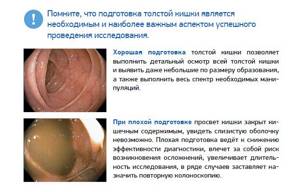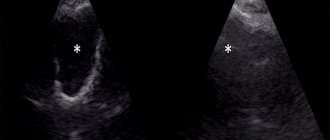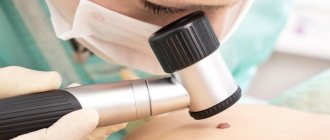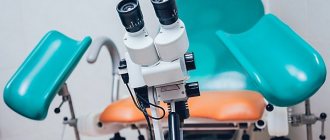Preparing for a colonoscopy
Preparing for a colonoscopy using various methods and tools
Colonoscopy, like any other endoscopic or x-ray method of examining the large intestine, can be informative only when there is no stool in the intestine. Therefore, proper preparation for a colonoscopy is a prerequisite for its successful completion.
How to properly prepare for a colonoscopy? To do this, two requirements must be met.
The first is a special, slag-free diet - preparation for the colonoscopy procedure cannot be complete without meeting this condition.
The second requirement is a thorough cleansing of the intestines, which can be accomplished in various ways. It must be remembered that preparation - diet and bowel cleansing - should be done in advance, and not directly on the day of the examination.
Residue-free diet before colonoscopy
What is she? What can you eat before a colonoscopy, and what should you absolutely avoid?
Slag foods include those foods that cause bloating and bulky stools. They are the ones that need to be excluded 2–3 days before the examination. The diet before a colonoscopy should not contain:
- Fresh vegetables (beets, carrots, cabbage, turnips, radishes, radishes, onions, garlic)
- Greens (sorrel, spinach)
- Some porridges (oatmeal, pearl barley, millet)
- Legumes (lentils, beans, peas, beans)
- Fruits (apricots, peaches, apples, dates, oranges, bananas, tangerines, grapes, raisins)
- Nuts
- Berries (raspberries, gooseberries)
- Black bread
- Milk, carbonated drinks and kvass
A colonoscopy diet may include:
- Hateful broths
- Lean boiled beef, poultry, fish
- Dairy products
- White wholemeal bread or soft biscuits
On the eve of the examination, the last meal should be no later than 12-00 noon. You can drink tea, mineral or plain water. Only tea is allowed for dinner. The morning meal before your colonoscopy should consist solely of liquids, such as tea or water.
Admission restrictions
The use of both drugs in pregnant and nursing mothers is necessary according to strict indications; in elderly and debilitated patients it is necessary under medical supervision. Also, both drugs are used only from 18 years of age. There is data on the use of Endofalk in children from 1 year of age (Adamiak T. et al. One-day bowel preparation with polyethylene glycol 3350: an effective regimen for colonoscopy in children. Gastrointest Endosc. 2010).
No effect on the control of machinery and vehicles has been identified when using Endofalk, but with Fortrans it is recommended with caution, especially if sedation with Propofol is used.
The use of “Fortrans” or “Endofalk” is limited in case of renal failure, inflammation of the intestinal mucosa, including the rectum, and is contraindicated in cases of gastric and duodenal ulcers (bleeding is possible).
Colonoscopy – preparation with enemas
The second mandatory requirement for quality preparation for colonoscopy is thorough bowel cleansing. Until recently, the only way to do this was through enemas. Many patients still prefer this method.
How to prepare for a colonoscopy using enemas? To properly cleanse the intestines, an enema should be given the evening before the examination and in the morning on the day of the colonoscopy.
In the evening, the intestines are cleansed twice: at 19-00 and 20-00 hours, or a little later - at 20-00 and 21-00 hours. A single enema volume should be at least one and a half liters, and the intestines should be “washed” until there is clean water.
An evening cleansing enema can be combined with taking laxatives. For example, drink 40 - 60 g of castor oil or a 25% solution of magnesium sulfate in an amount of 100 ml. This must be done no later than 16-00, so that the intestines are cleared before evening.
On the morning of the examination, the enema is repeated twice more - at 7-00 and 8-00.
The procedure for preparing for intestinal colonoscopy using cleansing enemas has both advantages and disadvantages.
The advantages of the method are its simplicity, accessibility and low cost, because it costs absolutely nothing. The disadvantages of the method are the inconvenience of doing it yourself and the need for an assistant. Indeed, a person who tries to independently give himself an enema with 1.5 liters of water has to simultaneously control the flow of fluid and try to retain this fluid in the intestines. Therefore, the procedure often turns out to be performed poorly.
In addition, preparing a patient for colonoscopy using enemas if he has hemorrhoids or cracks in the rectal mucosa can cause additional trauma to the enema tip.
Therefore, today, for a more comfortable and high-quality bowel cleansing before a colonoscopy, special laxatives are used, taken according to certain regimens.
Difficulty of choice
Due to different preparations, it is often necessary to answer patients’ questions, “which drug to choose for better preparation,” “Moviprep or Fortrans, which is better?”
I’ll make a reservation right away. There are drugs that patients prefer, and there are drugs that doctors prefer. It happens that a good drug works for one person, but does not work for another. But the drug, which is modest in properties, resonates with the latter.
People are all personalities and individuals. Doctors do not treat diseases, but people, who are all different, with different sets of characteristics and diseases. Therefore, the drug for bowel cleansing before colonoscopy sometimes has to be selected individually.
Preparation for the procedure with Fortrans
The drug is not absorbed from the gastrointestinal tract, acts exclusively in the intestines and is excreted unchanged.
Preparing for a Fortrans colonoscopy is quite simple. The whole package of the drug is diluted in 1 liter of water. The amount of solution for one patient is taken at the rate of 1 liter per 15 - 20 kg of body weight. On average, for an adult this volume is 3–4 liters.
There are two ways to take the prepared solution. The first involves drinking the entire volume on the eve of the examination, starting at 15-00, at a rate of approximately 1 glass per hour. With the second method, half of the solution is drunk the day before, and in the morning the patient consumes the remaining volume.
The last dose of Fortrans should be no later than 3–4 hours before the examination. This drug is produced specifically for preparing the intestines for endoscopic and x-ray examinations, as well as for operations on the colon.
Taste properties
If we compare “Endofalk” with other drugs, and in particular with “Fortrans”, then it (“Endofalk”) has a more pleasant taste due to the addition of citrus fruit flavors to the composition.
And when developing Fortrans, they probably didn’t think about taste. Therefore, improving the organoleptic (taste) properties of Fortrans was assigned to the patient. These tricks consisted of cooling the drug itself after diluting it in the refrigerator, adding 100 ml of freshly squeezed orange or lemon juice (without pulp and zest) to 1 packet of Fortrans per 900 ml of water, and washing down the drug itself with chilled plain water.
Preparation with Duphalac
Duphalac is another laxative that allows you to gently and effectively prepare the intestines for endoscopic examination.
The drug should be taken the day before, 2 hours after a light lunch. The entire bottle of Duphalac (200 ml) is diluted in 2 liters of plain water. Drink the prepared solution in sips, and the entire volume should be consumed within 2–3 hours.
Bowel movement begins 1 to 3 hours after starting to take Duphalac and ends 2 to 3 hours after taking the final dose. With the help of the drug Duphalac, preparation for the procedure is carried out gently and very comfortably for the patient.
Preparation for colonoscopy and rectosigmoidoscopy
Preparing the colon is perhaps the most important and sometimes difficult stage for patients.
If the preparation is poor, the intestinal lumen is partially closed by intestinal contents, and it is not possible to see the mucous membrane. Poor preparation entails the risk of complications during the examination, a decrease in the effectiveness of the diagnostic and treatment process, and an increase in examination time. If it is impossible to conduct a high-quality examination, a repeat procedure is prescribed.
To understand what is necessary for good preparation, you need to know a few rules:
- Follow a slag-free diet 3 days before the test
- On the day of preparation (the day before the study), limit yourself to breakfast and drink more liquids
- Know the time of your colonoscopy
- Divide the drug you have chosen for preparation into two doses!
There are many drugs for preparation, some that meet the standard - full-volume, some low-volume, some reserve.
The gold standard for the most effective and safe training -
4 liters of solution containing the drug, divided into 2 doses.
Yes, it may seem like you need to drink a lot of laxative solution, BUT the resulting quality will ensure the most effective and efficient examination!
Since 2011, we have introduced this standard as recommended by the clinic. This allows for high-quality colonoscopy, and if polyps are detected, they can be removed immediately. 90% of our patients rate this preparation and medications as completely tolerable, and those who undergo this study many times do not want to change the drug, because they are confident in the quality of the preparation!
The standard, recommended preparation scheme is as follows:
| 1st day before the start of preparation | 2nd day before the start of preparation | Day of preparation for the study , before taking cleansing drugs | Day of examination (colonoscopy) |
| Slag-free diet | Slag-free diet | Breakfast Liquids + Fortrans® + Defoamer | Fortrans®+Defoamer |
Step 1. Starts 3 days before your colonoscopy!
SLUG-FREE DIET BEFORE COLONOSCOPE*
(easily digestible, refined food, containing almost no indigestible substances)
Allowed:
- Flour products and rice: white bread made from enriched refined premium flour, porridge (rice, oatmeal), muffins, biscuits, bagels (bagels) - without poppy seeds, simple crackers (without additives), vermicelli and noodles made from premium flour, including .h. White rice.
- Meat: soups with low-fat meat broth; various, well-cooked dishes made from lean beef and veal; boiled chicken, also in the form of cutlets, meatballs, soufflé; egg
- Fish: dishes from cod, pike perch, perch, pike (low-fat fish)
- Dairy products: calcium-rich foods (low-fat cottage cheese, cheeses), natural yogurt (no additives!), no more than 2 glasses of skim milk
- Vegetables: vegetable broths, potatoes (without peel)
- Fruits and drinks: mousse, ½ banana, peach, melon. Tea, weak coffee, compotes, jelly and juices, preferably clear (without pulp, dried fruits, berries and grains!)
- Sweets: sugar, honey, jelly, syrup
- Possibly cooking, as well as consuming butter (butter, vegetable), mayonnaise, margarine in limited quantities.
Prohibited:
- Flour products and cereals: all grain-containing products (whole grains, products containing crushed grains, nuts, poppy seeds, coconut flakes, etc.), brown bread, cereals (not included in the list of permitted), legumes, peas, lentils, etc. .
- Vegetables and fruits: all fresh and dried vegetables and fruits, cabbage in any form (both fresh and cooked), raisins and berries, especially with small seeds, all varieties of greens (parsley, dill, lettuce, cilantro, basil and etc.)
- Soups: cabbage soup and borscht, milk soups, cream soups, okroshka
- Meat, fish: fatty fish and meats, duck, goose, smoked meats, sausages, frankfurters
- Dairy products: yogurt containing fillers (fruit, muesli), pudding, cream, sour cream, ice cream, full-fat cottage cheese
- Seasonings and canned food: hot seasonings (horseradish, pepper, mustard, onion, vinegar, garlic), as well as all seasonings (sauces) with grains, herbs, pickles, canned food, salted and pickled mushrooms, seaweed
- Drinks: alcoholic drinks, kvass, sparkling water, prune drinks
Following dietary restrictions greatly influences the preparation process!
Step 2. On the day of preparation for the study (the day before the endoscopy):
You can have breakfast (before 11 o'clock) according to the Slag-free diet
Next, you should only consume liquids (!) (clear broth, green tea, clear juices, jelly without berries, still water) during the day in unlimited quantities
18:00-20:00 – Fortrans® 2 liters: 1 sachet of the drug per 1 liter of water (DO NOT reduce the amount of liquid!) .
Drink the solution gradually: 1 liter over 1 hour, 250 ml. every 15 minutes.
Approximately 1 hour after starting to take the Fortrans solution, painless, loose stools will appear.
Bowel movement will end with the release of clear or slightly colored liquid 2-3 hours after taking the last dose of Fortrans solution.
21:00 – Defoamer (Simethicone), for example, Sub Simplex, Bobotik Espumisan in liquid form (emulsion, suspension, drops)! – bottle 30 ml .
Step 3. On the day of the test:
Early rise!
05:30-07:30 – Fortrans® 2 liters, 1 sachet of the drug per 1 liter of water ( DO NOT reduce the amount of liquid! ).
Drink the solution gradually: 1 liter over 1 hour, 250 ml. every 15 minutes.
Approximately 1 hour after starting to take the Fortrans solution, painless, loose stools will appear.
Bowel movement will end with the release of clear or slightly colored liquid 2-3 hours after taking the last dose of Fortrans solution.
06:00 – Defoamer (Simethicone), for example, Sub Simplex, Bobotik Espumisan in liquid form (emulsion, suspension, drops)! – ½ bottle 15ml .
- The drug will act on average for another 2-3 hours. The research time for preparation in this mode is 10:30-15:30. Only if the examination time is late 14:00-15:30 (!) it is possible to shift the morning medication intake by 30-60 minutes: 06:00-08:00 or 06:30-08:30.
- On the day of the study, it is forbidden to eat food or drink water (except for the preparation for preparation); you must be on an empty stomach! This is especially important if the study involves intravenous anesthesia. Liquid intake should be stopped 2 hours before.
- In the morning, you can take regularly used medications (for example, a blood pressure pill), only after you finish taking the laxative (after 7.30)
What can be done to make Fortrans tastier and easier to tolerate?
- Cool the solution!
- Squeeze lemon juice into the solution
- Use a drinking straw
- Drink slowly and gradually (2 liters over 2 hours), if you feel full, take a short break
- You can drink it with sweet clear apple juice.
After completing the study:
- The feeling of bloating may persist for some time, but since we are working on CO2, this sensation will be short-lived or absent altogether;
- You can drink and eat 30 minutes after the test;
- If a biopsy was performed, strong physical activity should be avoided during the day;
- It is not recommended to drive a car, operate any machinery, or make important decisions for 24 hours after intravenous anesthesia;
- If unusual symptoms or any circumstances that worry you appear during the first hours or days after the study, please inform me!

Do you have a question about how I feel about other medications, or what to do if a colonoscopy is scheduled for early in the morning?
I also welcome if the drug Endofalk is used for a full-volume regimen (it has the fruity taste of Passion Fruit), the only thing is that it is prepared differently: 2 sachets per 1 liter of water. The rest of the procedure corresponds to the above scheme.
If you have a colonoscopy scheduled for the period from 8.30-10.30 am!
Changing the regimen of taking the drug, most often the volume, does not change the rules of eating a slag-free diet 3 days before colonoscopy and the fluid regime on the eve of the immediate preparation.
You can use the following drug separation scheme:
On the day of preparation for the study (the day before endoscopy):
— during the day you should only consume liquids (!) (clear broth, green tea, clear juices, jelly without berries, still water) in unlimited quantities
18.00-21.00 Take Fortrans 3 liters.
1 sachet of the drug is dissolved in 1 liter of water. The total volume of the diluted drug should be 3 liters
Drink the solution gradually: 1 liter over 1 hour, 250 ml every 15 minutes.
While taking the Fortrans solution, painless, loose stools will appear.
Emptying of the colon will end with the release of clear or slightly colored liquid 2-3 hours after taking the last dose of the solution.
22:00 — Defoamer (Simethicone), for example, Sub Simplex, Bobotik Espumisan in liquid form (emulsion, suspension, drops)! Bottle – 30 ml
On the day of the study:
05:00-06:00 – Fortrans 1 liter
To prepare the solution you need to: dilute 1 sachet of the drug in 1 liter of water ( DO NOT reduce the amount of liquid! ).
Drink the solution gradually: 1 liter over 1 hour, 250 ml every 15 minutes.
While taking the solution, painless, loose stools will appear.
Emptying of the colon will end with the release of clear or slightly colored liquid 2 hours after taking the last dose of the solution.
06:00 – Defoamer (Simethicone), for example, Sub Simplex, Bobotik Espumisan in liquid form (emulsion, suspension, drops)! – ½ bottle, 15ml
If you have a small body weight (up to 60-65 kg - depending on height), there is no tendency to constipation, and you understand for sure that you cannot “master” the standard regimen
I can recommend a shortened version of preparation using Senade and Fortrans (or Endofalk), a slag-free diet and liquids the day before are required (see above), otherwise the scheme may not be as effective as we would like. If everything is followed, then the effectiveness of this scheme, according to our research, is 88%.
On the day of preparation for the study (the day before endoscopy):
— during the day you should only consume liquids (!) (clear broth, green tea, clear juices, jelly without berries, still water) in unlimited quantities
22:30 Taking Senade 27 mg (2 tablets)
22:00 — Defoamer (Simethicone), for example, Sub Simplex, Bobotik Espumisan in liquid form (emulsion, suspension, drops)! Bottle – 30 ml
On the day of the study:
05:30-07:30 – Fortrans 2 liters
To prepare the solution you need to: dilute 1 sachet of the drug in 1 liter of water ( DO NOT reduce the amount of liquid! ).
Drink the solution gradually: 1 liter over 1 hour, 250 ml every 15 minutes.
While taking the Fortrans solution, painless, loose stools will appear.
Emptying of the colon will end with the release of clear or slightly colored liquid 2-3 hours after taking the last dose of the solution.
06:00 – Defoamer (Simethicone), for example, Sub Simplex, Bobotik Espumisan in liquid form (emulsion, suspension, drops)! – ½ bottle, 15ml
*The drug Endofalk can be replaced with the drug Fortrans (also in a volume of 2 liters - diluted 2 sachets per 1 liter of water)
If you have had a negative experience or are intolerant to Fortrans, you can use other Moviprep medications (1 liter of the drug + 1 liter of water in the evening and a second dose of 1 liter of the drug + 1 liter in the morning). Picoprep also, dividing the reception into two stages! The quality of preparation can depend on many factors... so if you still have questions about how to make the preparation more successful, contact the clinic for advice!






